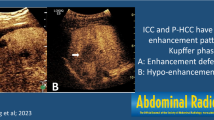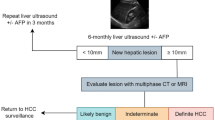Abstract
Objectives
The current study developed an ultrasound-based deep learning model to make preoperative differentiation among hepatocellular carcinoma (HCC), intrahepatic cholangiocarcinoma (ICC), and combined hepatocellular–cholangiocarcinoma (cHCC-ICC).
Methods
The B-mode ultrasound images of 465 patients with primary liver cancer were enrolled in model construction, comprising 264 HCCs, 105 ICCs, and 96 cHCC-ICCs, of which 50 cases were randomly selected to form an independent test cohort, and the rest of study population was assigned to a training and validation cohorts at the ratio of 4:1. Four deep learning models (Resnet18, MobileNet, DenseNet121, and Inception V3) were constructed, and the fivefold cross-validation was adopted to train and validate the performance of these models. The following indexes were calculated to determine the differential diagnosis performance of the models, including sensitivity, specificity, accuracy, positive predictive value (PPV), negative predictive value (NPV), F-1 score, and area under the receiver operating characteristic curve (AUC) based on images in the independent test cohort.
Results
Based on the fivefold cross-validation, the Resnet18 outperformed other models in terms of accuracy and robustness, with the overall training and validation accuracy as 99.73% (± 0.07%) and 99.35% (± 0.53%), respectively. Furthers validation based on the independent test cohort suggested that Resnet 18 yielded the best diagnostic performance in identifying HCC, ICC, and cHCC-ICC, with the sensitivity, specificity, accuracy, PPV, NPV, F1-score, and AUC of 84.59%, 92.65%, 86.00%, 85.82%, 92.99%, 92.37%, 85.07%, and 0.9237 (95% CI 0.8633, 0.9840).
Conclusion
Ultrasound-based deep learning algorithm appeared a promising diagnostic method for identifying cHCC-ICC, HCC, and ICC, which might play a role in clinical decision making and evaluation of prognosis.
Graphical abstract







Similar content being viewed by others
References
Beaufrère A, Calderaro J, Paradis V. Combined hepatocellular-cholangiocarcinoma: An update. Journal of hepatology. 2021;74(5):1212-1224.
Allen RA, Lisa JR. Combined liver cell and bile duct carcinoma. Am J Pathol. 1949;25(4):647-655.
Nagtegaal ID, Odze RD, Klimstra D, et al. The 2019 WHO classification of tumours of the digestive system. Histopathology. 2020;76(2):182-188.
Schizas D, Mastoraki A, Routsi E, et al. Combined hepatocellular-cholangiocarcinoma: An update on epidemiology, classification, diagnosis and management. Hepatobiliary Pancreat Dis Int. 2020;19(6):515-523.
Na SK, Choi GH, Lee HC, et al. The effectiveness of transarterial chemoembolization in recurrent hepatocellular-cholangiocarcinoma after resection. PloS one. 2018;13(6):e0198138.
Mukund A, Srinivasan S, Rana S, et al. Response evaluation of locoregional therapies in combined hepatocellular-cholangiocarcinoma and intrahepatic cholangiocarcinoma versus hepatocellular carcinoma: a propensity score matched study. Clinical radiology. 2022;77:121–129.
Liu WR, Tian MX, Tao CY, et al. Adjuvant Transarterial chemoembolization does not influence recurrence-free or overall survival in patients with combined hepatocellular carcinoma and Cholangiocarcinoma after curative resection: a propensity score matching analysis. BMC cancer. 2020;20(1):642.
Huang YH, Park BV, Chen YF, Gaba RC, Guzman G, Lokken RP. Locoregional Therapy of Hepatocellular-Cholangiocarcinoma versus Hepatocellular Carcinoma: A Propensity Score-Matched Study. Journal of vascular and interventional radiology : JVIR. 2019;30(9):1317-1324.
Yau T, Park JW, Finn RS, et al. Nivolumab versus sorafenib in advanced hepatocellular carcinoma (CheckMate 459): a randomised, multicentre, open-label, phase 3 trial. The Lancet Oncology. 2022;23:77–90.
Shi T, Iwama H, Fujita K, et al. Evaluating the effect of lenvatinib on sorafenib-resistant hepatocellular carcinoma cells. International journal of molecular sciences. 2021;22(23):13071.
Lamarca A, Barriuso J, McNamara MG, Valle JW. Molecular targeted therapies: Ready for “prime time” in biliary tract cancer. Journal of hepatology. 2020;73(1):170-185.
Kim EJ, Yoo C, Kang HJ, et al. Clinical outcomes of systemic therapy in patients with unresectable or metastatic combined hepatocellular-cholangiocarcinoma. Liver international : official journal of the International Association for the Study of the Liver. 2021;41(6):1398-1408.
Trikalinos NA, Zhou A, Doyle MBM, et al. Systemic Therapy for Combined Hepatocellular-Cholangiocarcinoma: A Single-Institution Experience. Journal of the National Comprehensive Cancer Network : JNCCN. 2018;16(10):1193-1199.
Chang CC, Chen YJ, Huang TH, et al. Living Donor Liver Transplantation for Combined Hepatocellular Carcinoma and Cholangiocarcinoma: Experience of a Single Center. Ann Transplant. 2017;22:115-120.
Bridgewater J, Galle PR, Khan SA, et al. Guidelines for the diagnosis and management of intrahepatic cholangiocarcinoma. Journal of hepatology. 2014;60(6):1268-1289.
Holzner ML, Tabrizian P, Parvin-Nejad FP, et al. Resection of Mixed Hepatocellular-Cholangiocarcinoma, Hepatocellular Carcinoma, and Intrahepatic Cholangiocarcinoma. Liver transplantation : official publication of the American Association for the Study of Liver Diseases and the International Liver Transplantation Society. 2020;26(7):888-898.
Leoni S, Sansone V, Lorenzo S, et al. Treatment of combined hepatocellular and cholangiocarcinoma. Cancers. 2020;12(4):794.
Yamashita YI, Aishima S, Nakao Y, et al. Clinicopathological characteristics of combined hepatocellular cholangiocarcinoma from the viewpoint of patient prognosis after hepatic resection: High rate of early recurrence and its predictors. Hepatology research : the official journal of the Japan Society of Hepatology. 2020;50(7):863-870.
Lee JH, Chung GE, Yu SJ, et al. Long-term prognosis of combined hepatocellular and cholangiocarcinoma after curative resection comparison with hepatocellular carcinoma and cholangiocarcinoma. J Clin Gastroenterol. 2011;45(1):69-75.
Song P, Midorikawa Y, Nakayama H, et al. Patients’ prognosis of intrahepatic cholangiocarcinoma and combined hepatocellular-cholangiocarcinoma after resection. Cancer medicine. 2019;8(13):5862-5871.
Borhani AA, Catania R, Velichko YS, Hectors S, Taouli B, Lewis S. Radiomics of hepatocellular carcinoma: promising roles in patient selection, prediction, and assessment of treatment response. Abdom Radiol (NY). 2021;46(8):3674-3685.
Castaldo A, De Lucia DR, Pontillo G, et al. State of the art in artificial intelligence and radiomics in hepatocellular carcinoma. Diagnostics (Basel). 2021;11(7):1194.
Yang JD, Heimbach JK. New advances in the diagnosis and management of hepatocellular carcinoma. Bmj. 2020;371:m3544.
Lo EC, A NR, Federle MP. Hepatocellular Carcinoma and Intrahepatic Cholangiocarcinoma: Imaging for Diagnosis, Tumor Response to Treatment and Liver Response to Radiation. Seminars in radiation oncology. 2018;28(4):267-276.
Sammon J, Fischer S, Menezes R, et al. MRI features of combined hepatocellular- cholangiocarcinoma versus mass forming intrahepatic cholangiocarcinoma. Cancer imaging : the official publication of the International Cancer Imaging Society. 2018;18(1):8.
Kim TH, Kim H, Joo I, Lee JM. Combined Hepatocellular-Cholangiocarcinoma: Changes in the 2019 World Health Organization Histological Classification System and Potential Impact on Imaging-Based Diagnosis. Korean J Radiol. 2020;21(10):1115-1125.
Dong Y, Teufel A, Trojan J, Berzigotti A, Cui XW, Dietrich CF. Contrast enhanced ultrasound in mixed hepatocellular cholangiocarcinoma: Case series and review of the literature. Dig Liver Dis. 2018;50(4):401-407.
Kim MY, Joo I, Kang HJ, Bae JS, Jeon SK, Lee JM. LI-RADS M (LR-M) criteria and reporting algorithm of v2018: diagnostic values in the assessment of primary liver cancers on gadoxetic acid-enhanced MRI. Abdom Radiol (NY). 2020;45(8):2440-2448.
Zou X, Luo Y, Morelli JN, Hu X, Shen Y, Hu D. Differentiation of hepatocellular carcinoma from intrahepatic cholangiocarcinoma and combined hepatocellular-cholangiocarcinoma in high-risk patients matched to MR field strength: diagnostic performance of LI-RADS version 2018. Abdominal radiology (New York). 2021;46(7):3168-3178.
Lee HS, Kim MJ, An C. How to utilize LR-M features of the LI-RADS to improve the diagnosis of combined hepatocellular-cholangiocarcinoma on gadoxetate-enhanced MRI? European radiology. 2019;29(5):2408-2416.
Li R, Yang D, Tang CL, et al. Combined hepatocellular carcinoma and cholangiocarcinoma (biphenotypic) tumors: clinical characteristics, imaging features of contrast-enhanced ultrasound and computed tomography. BMC cancer. 2016;16:158.
Harding-Theobald E, Louissaint J, Maraj B, et al. Systematic review: radiomics for the diagnosis and prognosis of hepatocellular carcinoma. Aliment Pharmacol Ther. 2021;54(7):890-901.
Zhou H, Jiang T, Li Q, et al. US-Based Deep Learning Model for Differentiating Hepatocellular Carcinoma (HCC) From Other Malignancy in Cirrhotic Patients. Frontiers in oncology. 2021;11:672055.
Akkus Z, Cai J, Boonrod A, et al. A Survey of Deep-Learning Applications in Ultrasound: Artificial Intelligence-Powered Ultrasound for Improving Clinical Workflow. J Am Coll Radiol. 2019;16(9 Pt B):1318-1328.
Feng B, Ma XH, Wang S, Cai W, Liu XB, Zhao XM. Application of artificial intelligence in preoperative imaging of hepatocellular carcinoma: Current status and future perspectives. World journal of gastroenterology. 2021;27(32):5341-5350.
Liu SC, Lai J, Huang JY, et al. Predicting microvascular invasion in hepatocellular carcinoma: a deep learning model validated across hospitals. Cancer imaging : the official publication of the International Cancer Imaging Society. 2021;21(1):56.
Zhang J, Huang Z, Cao L, et al. Differentiation combined hepatocellular and cholangiocarcinoma from intrahepatic cholangiocarcinoma based on radiomics machine learning. Ann Transl Med. 2020;8(4):119.
Liu X, Khalvati F, Namdar K, et al. Can machine learning radiomics provide pre-operative differentiation of combined hepatocellular cholangiocarcinoma from hepatocellular carcinoma and cholangiocarcinoma to inform optimal treatment planning? Eur Radiol. 2021;31(1):244-255.
Peng Y, Lin P, Wu L, et al. Ultrasound-Based Radiomics Analysis for Preoperatively Predicting Different Histopathological Subtypes of Primary Liver Cancer. Front Oncol. 2020;10:1646.
Acknowledgement
Not applicable.
Funding
The research was supported by Clinical Study of Shanghai Municipal Health Commission (No. 20194Y0473).
Author information
Authors and Affiliations
Corresponding authors
Ethics declarations
Conflict of interest
All authors declare no conflict of interest.
Additional information
Publisher's Note
Springer Nature remains neutral with regard to jurisdictional claims in published maps and institutional affiliations.
Rights and permissions
Springer Nature or its licensor (e.g. a society or other partner) holds exclusive rights to this article under a publishing agreement with the author(s) or other rightsholder(s); author self-archiving of the accepted manuscript version of this article is solely governed by the terms of such publishing agreement and applicable law.
About this article
Cite this article
Chen, J., Zhang, W., Bao, J. et al. Implications of ultrasound-based deep learning model for preoperatively differentiating combined hepatocellular-cholangiocarcinoma from hepatocellular carcinoma and intrahepatic cholangiocarcinoma. Abdom Radiol 49, 93–102 (2024). https://doi.org/10.1007/s00261-023-04089-4
Received:
Revised:
Accepted:
Published:
Issue Date:
DOI: https://doi.org/10.1007/s00261-023-04089-4




